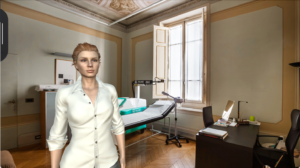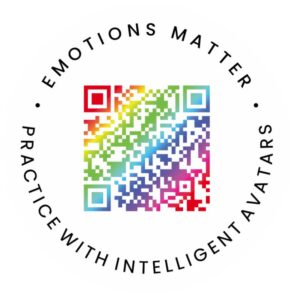
Hi everybody! I am Anna, a Real Time Avatar. I not only participate in different international simulation conferences to showcase progress in digital humans-development and present my unique spatial placement ability, but I’m also a working avatar in projects like communication training courses for empathic communication and emotions management. To find out more, read here!
Being a Real Time Avatar
You’ve met my colleague Matt, so you probably don’t need an explanation of what a Real Time Avatar is. If you don’t know it, then you can go and read his post before you continue. He likes to boast that he’s THE Real Time Avatar, but as you might have understood by now, he’s not working alone. I’d love for you to meet our other colleagues, but I’m afraid they are all too busy even for the shortest of appearances on the DigiBlog and you’ll have to make do with Matt and me.
Our team has the same base abilities that – no wonder here – make us Real Time Avatars, yet as I’ll explain in more detail later, we are not all the same because I was given an additional special feature. Why do only I have it? Well, I’m more responsible, Matt would just play around with it all the time. Have you read how he thinks he’s a superhero just because he can change his looks and setting? I can do that too, yet I’m not here pretending I’m wonder woman… Still, he’s a great Real Time Avatar and as good digital humans are hard to find, we collaborate from time to time on other projects where we are featured as normal scenario characters. It’s just like having an actor side career… but I’m digressing, let’s get back to the point, I promised you to tell you about my special feature.

A digital human in the real world
So, what is this special ability that I have? As Matt has explained to you a few weeks ago, Real Time Avatars can be placed in different settings. The other team members have the choice between a variety of digital backgrounds that have been selected to simulate different scenarios, I on the other hand, can also be put in the real world. A digital human in the real world, it doesn’t sound possible, does it? And yet it is, I can assure you. This feature is an absolute attention grabber when I travel to conferences, because people always love to try it. But we don’t do things just for fun here, it has also functionality. If you want for example to simulate a scenario in a setting that’s not provided in the e-REAL gallery because it’s very specific to your facility, I can be placed in that physical room and still work as a Real Time Avatar. Isn’t that amazing?!
How does it work? You scan a QR code with your phone and then point the camera in the room where you want to place me, touch the screen and… magic! I’m right there! Now, this QR code has been developed as a demonstration, so I’ll be talking to you, but not in real time and you can’t ask anything back, but if you want to see a Real Time Avatar in action you can just schedule a demo with Matt or me and we’ll clear all you questions and doubts. Here, try it!

Emotions and empathy training in a clinical setting
Let me give you an example of how Real Time Avatars like me can be used to train communication skills in different settings, like the clinical one. At Montgomery College in Takoma Park, USA, I took part in a program to train future sonographers.
A sonographer’s communication skills are especially important to obtain all medical information from the patient, but also to build trust through empathy and keep the patient calm, so that the results may be accurate. My ability to reproduce non-verbal communication and human emotions at different levels makes it possible for students to train their reactions to specific situations and learn to assess the emotional state of the patient in front of them. The students are of course also trained in communication itself, learning better ways to address specific situations, like how to calm a patient down or how to explain important information in non-technical terms.
The fact that the looks of the Real Time Avatars can be customized to represent different ethnicities can also be used to train the students in multicultural communication and issues that revolve around cultural and language barriers, reducing future risks of misinterpretation in their work line.
The program revealed crucial results for digital humans-research, summarized in the paper “Improving Sonographer-Patient Communication in a Diverse and Multicultural Environment Through Role-Plays with Digital Humans” by Barbara Bertagni, Linda Zanin, Fernando Salvetti and Ianna Contardo (2023)1</. The students especially appreciated to be able to learn at their own pace, as well as the opportunity to train with very diverse patients that human simulation usually can’t offer to that same level, and the ability of us Real Time Avatars to gather data and give them feedback about their performance. Still, my work is not complete yet, there is more research to be done to unlock the full potential of digital human role-playing.
As much as I love explaining my job to you and I hope to at least have sparked your curiosity about the potential of digital humans, I really have to go now. Stay tuned for the next guest on the DigiBlog next week!
1Bertagni, B., Zanin, L., Salvetti, F., Contardo, I. (2023). Improving Sonographer-Patient Communication in a Diverse and Multicultural Environment Through Role-Plays with Digital Humans. In: Guralnick, D., Auer, M.E., Poce, A. (eds) Creative Approaches to Technology-Enhanced Learning for the Workplace and Higher Education. TLIC 2023. Lecture Notes in Networks and Systems, vol 767. Springer, Cham. https://doi.org/10.1007/978-3-031-41637-8_5
